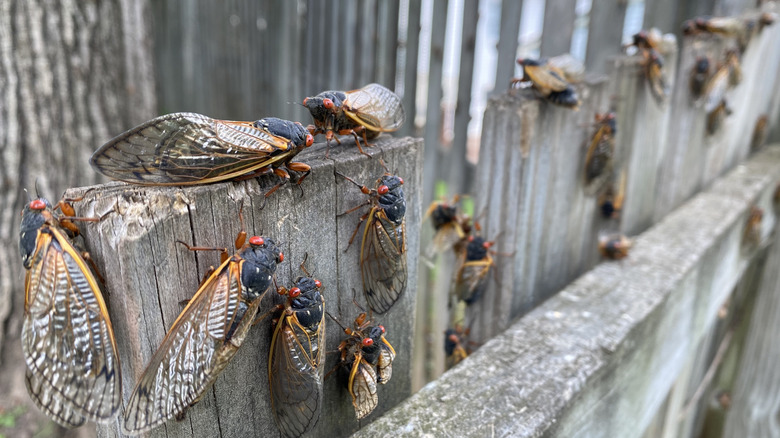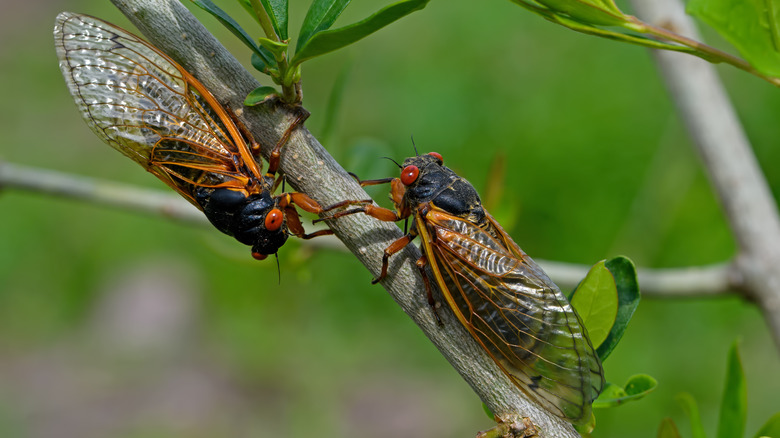Here's What Is Attracting Noisy Cicadas To Your Yard
While a few cicadas in your backyard can be nostalgic, having a whole flock — as you may see during an emergence — can be annoying. What's more, you might unintentionally attract them to your yard by doing motorized yard work during the day, not netting vulnerable trees, or failing to provide a habitat suitable for cicada predators. In fact, simply living in an established neighborhood with lots of mature trees can make your yard a cicada magnet. Thankfully, there are some relatively easy ways to keep cicadas out of your yard — or at least limit their numbers.
Cicadas spend their early years underground, feeding on tree root sap. At certain times of the year, they dig their way out, climb the nearest tree, and transform into a flying adult cicada. There are two kinds of cicadas in the U.S.: dog-day cicadas (all the Tibicen species) and annual cicadas (the Magicicada genus). The former emerges from the ground every year, and the latter emerges simultaneously on a 13- or 17-year cycle, called a brood. The brood event back in 2021 got a lot of coverage, and there's also an even more immense than usual dual emergence event in 2024. Either way, you can expect cicadas in backyards, parks, and forests from July through September. Because cicadas wait until the soil warms to 64 degrees Fahrenheit to emerge, their activities are used by scientists to measure how climate change is affecting the earth's ecosystems.
Why cicadas can't resist woody trees or lawnmowers
Cicadas complete their lifecycles where mature trees have stood continuously for at least 17 or more years and where no urban development or construction has occurred. They target woody 3/16-inch to 7/16-inch diameter branches free from bark and for egg laying. To get even more specific, researchers have documented at least 270 plant species favored by female cicadas, including willow, maple, oak, hickory, beech, ash, dogwood, hawthorn, magnolia, willow, fruit trees (apple, peach, cherry, and pear), Rose of Sharon, roses, raspberries, grape vines, black-eyed Susan, hollies, spirea, rhododendrons, viburnum, junipers, arborvitae, blueberries, and brambles. They're also particularly fond of deciduous trees like Eastern Redbuds.
They prefer to congregate in places with tall, wooden objects to climb on to change from baby grub to flying adult insect. Then, they move to tall grass, shrubs, or other dense vegetation right after. There, the males congregate to make the loud noises — up to an astonishing 90 decibels — that indicate to humans that summer has well and truly arrived and to female cicadas that they're ready to mate! The sounds of lawnmowers and other motorized power tools mimic the sounds and vibrations of male cicadas so closely that you risk being harassed by frisky cicadas if you start them up during emergence or in late summer. Back in 2013, botanists also discovered male cicadas are attracted to soft clicking sounds, like turning a light switch on and off, because it imitates female cicada noise-making, reports PBS.
How to make your yard less attractive to cicadas
As mentioned above, cicadas prefer established ecosystems; if you want to avoid cicadas altogether, buy or rent in a residential development less than 50 years old. You also need to know cicadas are coming and how to protect your plants. Starting in early spring, cover young trees with trunks less than 2 inches thick with netting to protect them from egg-laying female cicadas. Don't leave gaps or determined cicadas will find a way in. Wait to plant saplings until at least the end of June, too. Inspect the branches of trees and shrubs for signs of egg laying, and prune them off to reduce future cicada populations.
Since motorized yard equipment attracts cicadas, do yard work in the early morning or late evening; cicadas are most active in the daytime. As pesky as these insects are, they're an important food source for mammals, reptiles, and birds — from foxes to Eastern screech owls. During an emergence, these critters feast on so many cicadas they get sick of them! Holes in your lawn might indicate raccoons, crows, or other hungry backyard visitors have been digging up cicada larvae. Arachnids and other insects prey on cicadas, too, most famously the scarily large cicada killer wasps, though they target dog-day cicadas only. Encourage these predators by recreating favored ecosystems. For example, cicada killers prefer sunny landscapes with little vegetation, sandy soils, or paving. Attract birds to your garden with feeders, birdbaths, nest boxes, and avian-friendly plants.


